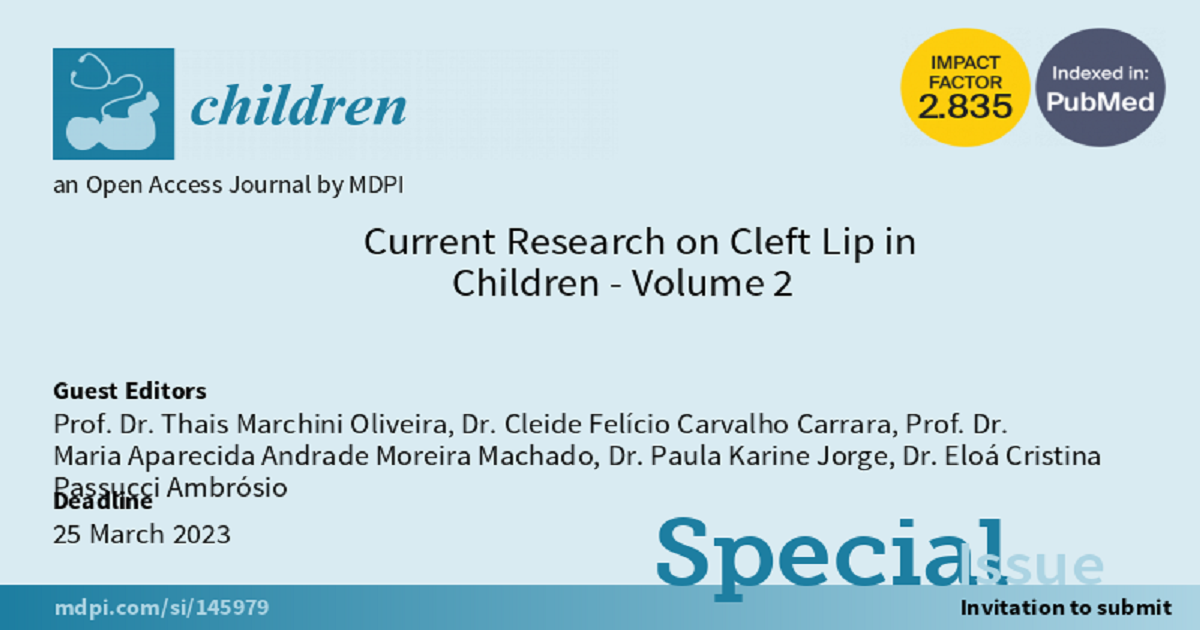Current Research on Cleft Lip in Children - Volume 2
A special issue of Children (ISSN 2227-9067). This special issue belongs to the section "Pediatric Dentistry".
Deadline for manuscript submissions: 5 June 2024 | Viewed by 5731

Special Issue Editors
Interests: children with oral clefts and the relation to the rehabilitative progress of children; in terms of medicine; speech; dentistry; physiology; psychology
Special Issues, Collections and Topics in MDPI journals
Interests: cleft lip and palate; pediatric dentistry; tooth eruption and orthodontics
Interests: pediatric dentistry
Interests: pediatric dentistry; cleft lip and palate; proteome
Interests: pediatric dentistry; anomalies craniofacial; cleft lip; cleft palate; 3D image
Special Issue Information
Dear Colleagues,
This issue will include papers all about oral clefts. In order to expand the evaluation and management of experimental and theoretical results about aspects of quality of life, growth and development, speech disorders, epidemiological, genetics and environmental factors linked with oral clefts. In order to increase understanding of fundamental principles and biological questions of oral clefts.
Aims
Children (ISSN 2227-9067), Special Issue about Current Research on Cleft Lip in Children is an international, open access journal dedicated to a streamlined, yet scientifically rigorous, dissemination of peer-reviewed science related to children with oral clefts in developed and developing countries.
The publication focuses on sharing clinical, epidemiological and translational science relevant to children with oral clefs. Moreover, the primary goals of the publication are to highlight knowledge about all aspects of children with an oral cleft, such as epidemiological, clinical challenges, etiology, speech disorders, quality of life, growth and development, and related anomalies in order to rehabilitate and reinsert patients into society. In addition to original research, the journal publishes expert editorials and commentaries, clinical case reports, and insightful communications reflecting the latest developments in children with oral clefs. By publishing meritorious articles as soon as the editorial review process is completed, rather than at predefined intervals, Children also permits rapid open access sharing of new information, allowing us to reach the broadest audience in the most expedient fashion.
Scope
Articles in Children include, but are not limited to:
- Public Health and Epidemiology
- Growth and Development
- Maxilla
- Dental cast
- Three dimensional imaging
- Facial profile
- Relationship maxila and mandible.
- Pediatric Subspecialties
- Neurology
- Developmental/Behavioral Medicine
- Neonatal/Perinatal Medicine
- Plastic Surgery
- Sistemic disorders
- Quality of life
- Family relationship
- Society
- Patient with oral clefts itself
- Psychologic aspects
- Speech disorders
- Etiology
- Genetics
- Environment
- Epidemiology
- General apstects
[*] What kind of papers we are soliciting:
We are receiving papers of Research/ Review/ Case Reports / Short Communication/ Literature review/Systematic Review
Prof. Dr. Thais Marchini Oliveira
Dr. Cleide Felício Carvalho Carrara
Prof. Dr. Maria Aparecida Andrade Moreira Machado
Dr. Paula Karine Jorge
Dr. Eloá Cristina Passucci Ambrósio
Guest Editors
Manuscript Submission Information
Manuscripts should be submitted online at www.mdpi.com by registering and logging in to this website. Once you are registered, click here to go to the submission form. Manuscripts can be submitted until the deadline. All submissions that pass pre-check are peer-reviewed. Accepted papers will be published continuously in the journal (as soon as accepted) and will be listed together on the special issue website. Research articles, review articles as well as short communications are invited. For planned papers, a title and short abstract (about 100 words) can be sent to the Editorial Office for announcement on this website.
Submitted manuscripts should not have been published previously, nor be under consideration for publication elsewhere (except conference proceedings papers). All manuscripts are thoroughly refereed through a single-blind peer-review process. A guide for authors and other relevant information for submission of manuscripts is available on the Instructions for Authors page. Children is an international peer-reviewed open access monthly journal published by MDPI.
Please visit the Instructions for Authors page before submitting a manuscript. The Article Processing Charge (APC) for publication in this open access journal is 2400 CHF (Swiss Francs). Submitted papers should be well formatted and use good English. Authors may use MDPI's English editing service prior to publication or during author revisions.
Keywords
- oral clefts
- cleft lip and palate
- growth and development
- speech disorders
- quality of life
- etiology
- genetics and enviroment factors






